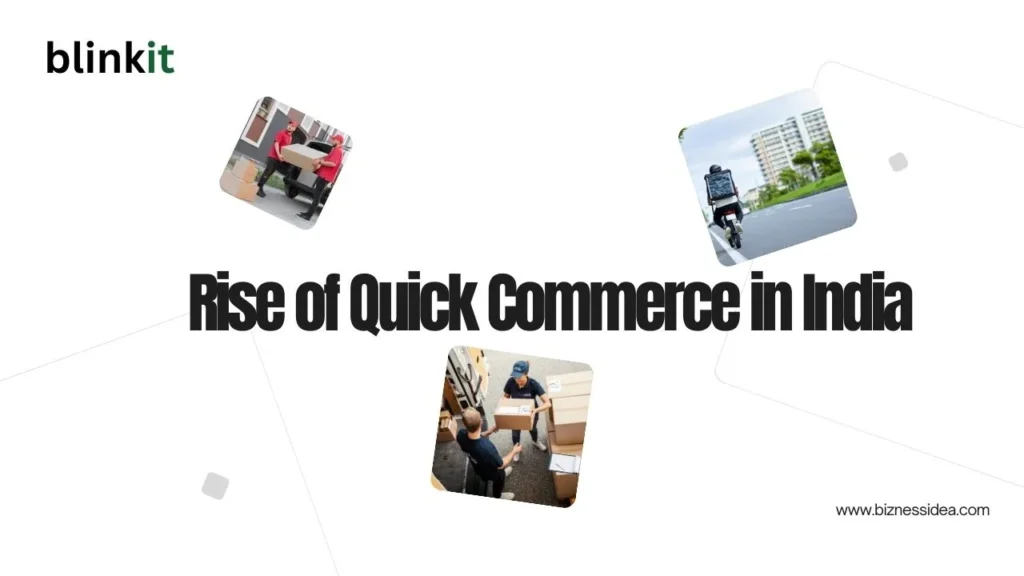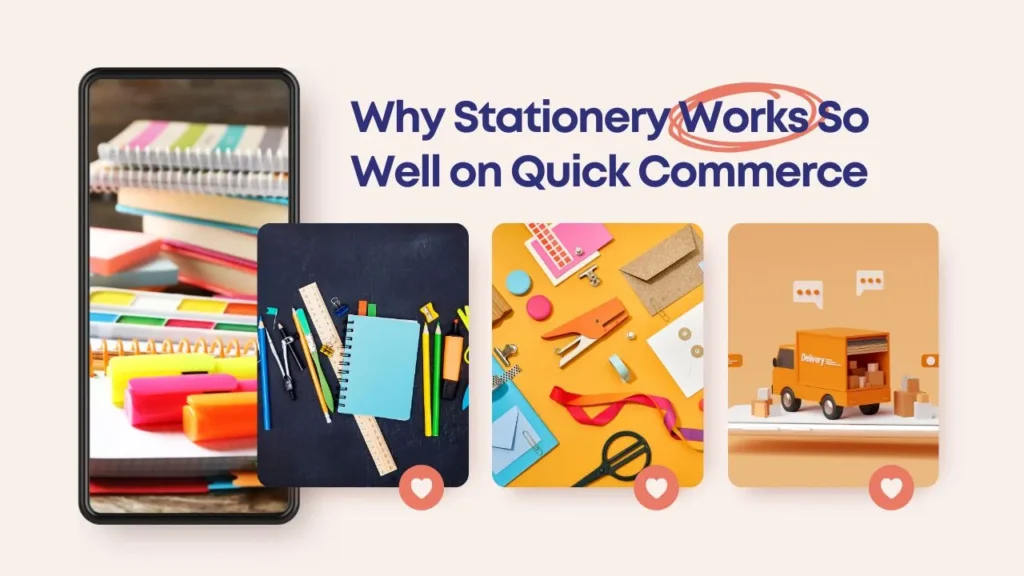The growth of quick commerce in India has changed the way consumers shop. From groceries to medicines, platforms like Blinkit, Zepto, and Swiggy Instamart have become household names for ultra-fast delivery. But what’s truly fascinating is how Blinkit turned a seemingly “fringe” category — stationery — into a ₹500 Cr+ fast-moving business segment.
In this case study, we’ll break down how the Blinkit Stationery Category rose to prominence, why consumer demand for stationery works well with quick commerce, and what business lessons startups and entrepreneurs can learn from this remarkable growth story.
The Rise of Quick Commerce in India: Like Blinkit Stationery Category

Quick commerce is all about delivering essentials within 10–20 minutes. What started as grocery delivery quickly expanded into multiple categories, including beauty, electronics, and now stationery.
India’s urban consumer base values speed and convenience. This shift in buying behavior opened up opportunities for companies like Blinkit to explore new categories beyond groceries.
As per industry reports, quick commerce is expected to be a $5 billion+ market by 2025, and Blinkit has positioned itself as a leader in this transformation.
From Fringe to ₹500 Cr: Blinkit Stationery Category Growth
Stationery has traditionally been a low-priority retail category, usually bought in bulk at local shops or supermarkets. But Blinkit spotted an opportunity — what if consumers could get a notebook, pen, or printer cartridge delivered at their doorstep within minutes?
This simple idea scaled massively. Today, the Blinkit Stationery Category contributes over ₹500 Cr in sales, making it one of the fastest-growing non-grocery categories in quick commerce.
Key drivers behind this growth include:
- Work From Home (WFH) boom: Professionals suddenly needed stationery for remote work setups.
- Student demand: With hybrid schooling, there was consistent need for supplies.
- Impulse buying: Customers often added stationery items while shopping for groceries.
- High convenience factor: Instead of visiting a local shop, consumers could get urgent stationery items within minutes.
The result? A category once considered “fringe” became a core revenue stream.
Why Stationery Works So Well on Quick Commerce

Stationery is not as glamorous as electronics or fashion, but it fits perfectly into the quick commerce model.
Here’s why:
- High frequency of urgent needs
- Running out of pens before an exam.
- Needing printer paper for office work.
- Forgetting a geometry box before a test.
- Low-ticket, high-volume sales
- Individual items are inexpensive, but the basket size grows when customers buy multiple supplies.
- Cross-selling opportunities
- Stationery often gets added along with grocery or snack orders, boosting overall average order value (AOV).
- Hyperlocal availability
- Easy for Blinkit to stock and deliver through dark stores.
This makes stationery one of the most profitable non-core categories in Blinkit’s portfolio.
Business Lessons from Blinkit’s Stationery Category Strategy
The Blinkit Stationery Category success is more than just about selling pens and notebooks. It’s a blueprint for how businesses can unlock hidden opportunities in “ignored” categories.
Here are the top lessons:
1. Spotting underserved categories
Most e-commerce players ignored stationery. Blinkit realized it was a daily need with no strong online presence, and seized the gap.
2. Leveraging speed as a USP
Consumers don’t want to wait two days for a pen refill or a notebook. Blinkit turned speed into a competitive advantage.
3. Creating habit purchases
Stationery is a repetitive purchase category. Once consumers got used to ordering from Blinkit, they rarely went back to offline shops.
4. Building trust through consistency
Timely delivery and last-mile efficiency made Blinkit the go-to platform for stationery needs.
Opportunities Like Blinkit Stationery Category for Entrepreneurs & Startups
Blinkit’s story is full of insights for entrepreneurs and startups in India.
- Think beyond core categories: Sometimes the next big revenue stream lies in the small things.
- Focus on consumer pain points: Solve urgent problems (e.g., forgotten stationery before an exam).
- Leverage cross-selling: Pair low-value items with high-frequency essentials.
- Niche quick commerce: There’s room for specialized quick delivery startups in categories like toys, pet care, or hardware supplies.
In short: Don’t just chase the obvious categories. The Blinkit stationery case study proves that even small markets can scale when combined with smart distribution.
Challenges & Risks in Scaling Non-Core Categories
Of course, it hasn’t been all smooth sailing. Expanding into categories like stationery comes with challenges:
- Inventory management: Stocking hundreds of low-value SKUs across multiple dark stores.
- Thin margins: Stationery is a low-margin product; profitability depends on volume and basket size.
- Demand fluctuations: Peaks during back-to-school season, exams, or WFH spikes, but demand may fall otherwise.
These challenges show why execution matters as much as strategy.
Future of Quick Commerce Categories in India
If Blinkit could scale stationery to ₹500 Cr+, what’s next? Experts suggest categories like:
- Toys & kids’ products (urgent needs for parents).
- Pet care supplies (food, grooming items, urgent medicine).
- Home repair essentials (bulbs, batteries, hardware).
Coupled with AI-driven demand forecasting, quick commerce platforms can continue expanding into non-traditional FMCG segments.
Conclusion
The Blinkit Stationery Category success is a masterclass in business innovation. By turning a low-priority, niche category into a ₹500 Cr+ business, Blinkit proved that growth doesn’t always come from the obvious categories.
For entrepreneurs, the key lesson is simple: Look for overlooked markets, solve urgent problems, and use speed as a USP.
Quick commerce is not just about groceries anymore. It’s about spotting the hidden gems — like stationery — and building them into fast-moving, high-value categories.
So the next time you order a notebook on Blinkit, remember: it’s not just a purchase, it’s part of a business strategy worth studying.
FAQs
Que 1. How did the Blinkit Stationery Category become a ₹500 Cr business?
Ans. By leveraging urgent consumer needs, impulse buying, and cross-selling with groceries, Blinkit scaled stationery into a high-volume category.
Que 2. Why is stationery successful in quick commerce?
Ans. Because it fulfills urgent, repetitive needs with small ticket sizes that add up to significant sales volume.
Que 3. What can startups learn from Blinkit’s stationery success?
Ans. Identify underserved categories, leverage speed, and create habit purchases that drive repeat demand.
Que 4. What’s next after stationery in quick commerce?
Ans. Potential categories include toys, pet care, and home essentials.













